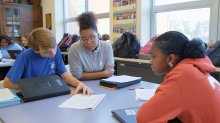How an Apprenticeship Model Engaged Students and Turned a School Around
At Maplewood Richmond Heights High School, educators think of school as an apprenticeship for kids’ futures—and it’s working.
Your content has been saved!
Go to My Saved Content.When Jal Mehta, a professor at the Harvard Graduate School of Education, and then-doctoral candidate Sarah Fine went looking for examples of deeper learning in American high schools, they discovered that highly effective teachers frequently allow students to learn by working in real-world contexts, like apprenticeships. This approach, they note in their 2019 book In Search of Deeper Learning: The Quest to Remake the American High School, empowers students to think of themselves as experts capable of harnessing their own creativity and using their knowledge and skills to develop mastery.
It’s also an approach that tends to feel particularly compelling to young people. “One of the things that people often observe is that kids are much more involved in sports and music than they are in, for example, math or science or writing,“ professor and New York Times bestselling author Alison Gopnik told us in 2016. “I think it’s because sports and music are among the very few places where we actually teach older children using this apprenticeship model. It’s where you actually learn how to do something actively and get feedback. Children are very enthusiastic about that model. There’s no reason at all why we shouldn’t teach writing or science or any of those kinds of activities the same way.”
At Maplewood Richmond Heights High School in suburban St. Louis, an emphasis on the apprenticeship model began in 2008 in response to years of underperformance that had led the school to the brink of a government-mandated shutdown. Today, in every class, teachers find ways to connect lessons to real-life people, places, and opportunities. For example, students working in the print shop receive orders from teachers to design posters and brochures for classrooms, and they are also responsible for creating the school’s student ID cards. In a service learning class, students practice teaching the school’s four cornerstones to middle school students—leadership, stewardship, scholarship, and citizenship—giving them a feel for the teaching profession. Local architects, nurses, engineers, and graphic designers are invited into classrooms to chat with kids about their jobs, and students are connected to job-shadowing and internship opportunities in the community.
In an ongoing effort to raise the bar on student work, the stellar work of former students who have achieved mastery is regularly archived and then used to inspire current students. And because school and district stakeholders decided in 2014 to prioritize belonging and inclusion in their goals for improving the local educational experience, educators from the high school—and the surrounding district—visit all incoming students at home in an effort to build trust and form deep, long-lasting relationships “in which [teachers, parents, and guardians] can take the time to share dreams, expectations, experiences, and tools regarding the student’s academic success,” says the school’s website.
Home Visits
Home visits to all incoming students began in 2008, and after one year, the district reported a 45 percent decrease in discipline referrals. Administrators, teachers, and counselors receive a stipend and summer training to prepare them for the visits. Home visits, research shows, strengthen trust and understanding with students and families, which in turn impacts academic success. “Until we started doing [home visits], all the programs and all the talk didn’t matter,” said Kevin Grawer, principal at Maplewood Richmond Heights High. “We had to prove that we were there for them. That we were there for the community. That it’s about improving our kids’ lives and giving them opportunities.”
Understanding by Design
Teachers at MRH High plan lessons using the Understanding by Design (UbD) framework. Using UbD for curriculum planning means teachers design curriculum, and plan lessons and assessments, by starting with the end point in mind and then working backward from there. Teachers ask themselves, “What do you want your students to walk away with?” and “What are the big ideas students should learn in the unit?”
Models of Excellence
As part of their apprenticeship philosophy, teachers at MRH High use a practice called Models of Excellence to show students what the expectations are for a project or assignment. By viewing examples of high-quality work that was completed in prior years by other students, kids begin to understand what good work looks like and to see it as achievable. This also happens to be one way that adults improve their skills in the real world: by observing the work of more experienced colleagues.
Teacher Apprenticeship Goals
In addition to connecting students with internships and other real-world work opportunities, teachers at MRH High plan their curriculum so that it’s as authentic as possible and grounded in the real world. As they produce lessons, teachers must identify two to three goals that connect the curriculum to real-world experiences or make the content applicable in the real world. These goals might include inviting a guest speaker, taking field trips, or inviting experts to evaluate student work.
The guiding philosophy of “school as apprenticeship” means that in every class, educators try to expose students to some semblance of what their working lives will be like after high school. “The goal is to [give students] a varied breadth of experiences but also to start to hone in on what you really want to do,” says Grawer, the principal. “Sometimes I have kids say, ‘I’m not sure what I want to do.’ I say, ‘That’s OK. You’re 17. A lot of people don’t know [what they want to do at 17]. But you’ve started the process early, and you’re further along than you would have been if you hadn’t been in this space. And that’s valuable.’”
